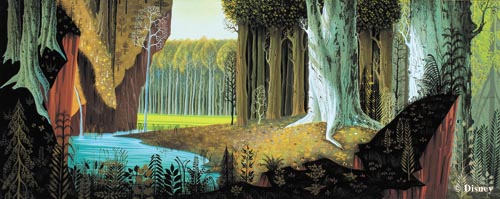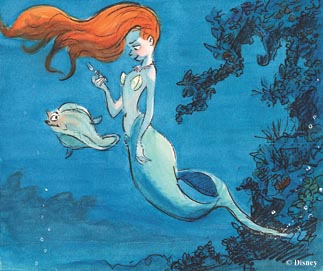Archive director talks about art behind Disney

Lella Smith, director of Walt Disney Animation Research Library, explains works of art on display at “Dreams Come True: The Art of Disney’s Classic Fairy Tales” at the Seoul Arts Center in Seocho District. Provided by Ode Inc.
What do the Walt Disney Company’s animated films have to do with fine art? In fact, many of its films have been influenced by fine art paintings, as evidenced in “Tangled” (2010), which was heavily inspired by the Baroque master Rembrandt. And some characters in “Fantasia” (1940) relied heavily on Victorian-era fairy paintings.
Many renowned illustrators such as Kay Nielsen - among the leaders of the so-called Golden Age of Illustration (late 19th to early 20th centuries) - participated in the Disney projects. Their work in the films, including Mary Blair’s concept art for “Cinderella” (1950) and Eyvind Earle’s background paintings for “Sleeping Beauty” (1959), has a beauty comparable to that of fine art paintings.
By showing these works, the exhibition “Dreams Come True: The Art of Disney’s Classic Fairy Tales” is helping viewers understand the artistic aspects of the 80-year-old entertainment giant’s animated films. On display at Hangaram Design Museum at the Seoul Arts Center in Seocho District are about 600 pieces of original concept works, sketches, storyboards, final frame cells, background paintings and movie clips from the Walt Disney Animation Research Library.
The exhibition, divided into nine sections, starts with Disney’s early short films including “Three Little Pigs” (1933) and ends with the 3-D film “Tangled” based on the fairy tale “Rapunzel.” It shows not only artworks behind the films’ scenes, but also how the films’ narratives, characters and visual effects evolved with the changes of social backgrounds and development of technology.

Eyvind Earle’s (1916-2000) background painting for “Sleeping Beauty” (1959). He was responsible for the film’s styling, background and colors.
Korean film experts might sigh at the exhibition, envious of Walt Disney ARL’s meticulous archiving. Many local classic films such as the 1966 film “Late Autumn” - which was so acclaimed as to spawn four remakes - are lost, as Koreans neglected archiving.
Lella Smith, the director of Walt Disney ARL, said that the library has approximately 60 million works of art, including sketches and cells. Most are not open to public viewing.
The Korea JoongAng Daily recently met Smith at the Seoul Arts Center, and talked about artists’ behind-the-scenes works on animated films and the evolution of film.
Q. The exhibition seems to prove that most villains in Disney animations from the first full-length film “Snow White and the Seven Dwarfs” to the latest hit “Tangled” come to an end by falling off a cliff, the rooftop, etc. Is it a tradition that will never change?
A. It is up to the storytellers. (Laugh) Maybe it’s time for another kind of ending. However, it is less scary than some endings.
Look at Snow White. The Evil Queen, in the Brothers Grimm’s tale, is forced to wear red-hot iron shoes and dance until she drops down dead, in the ending.
Walt Disney was in the business of making family films, a reflection of his love for children. Sometimes, he had to cut out parts of traditional fairy tales. As for “Snow White and the Seven Dwarfs,” Disney chose to have the Evil Queen die earlier (by falling off a cliff) in the story to focus on the princess’ happy ending with the prince.
Some people complain about the “Disney-style” changes to traditional stories. What do you think?
Fairy tales change every time they are told, depending on the audience. Storytellers of Disney, turning a three- to four-page story into a feature film, develop characters and locations upon careful consideration.
“Beauty and the Beast” (1992) is a good example about how Disney storytellers change the original story. In the traditional story, Belle has some sisters that are very mean to her and are jealous of her. They are turned into stones in the end, because their heart cannot soften. Disney storytellers removed parts of the sisters to focus on Belle, who is able to see through people. She sees through Gaston, who is mean and empty despite his handsome appearance. He was not in the traditional story. He was put in the film for contrast with the Beast, who has inner beauty.
But I also hope that parents will read the traditional or original fairy tales to the children, so that they could know that Disney stories are only one version of the tales.
This exhibition shows that a lot of artists participate in the creation of a single character. How do they work together and reach an agreement?

Glen Keane’s concept art for “The Little Mermaid” (1989). Walt Disney ARL director Lella Smith said his concept art was so attractive that it was chosen for the final film without much correction. Provided by Disney ARL and Ode Inc.
And there are artists called animators who actually draw the characters. They work based on character concepts made by the concept artists but adjust the concepts, talking with concept artists, “I like that girl’s height but I don’t like her hair.”
So the process is pretty flexible?
Sometimes, as a rare case, one drawing is presented and everybody nods and that’s it. The sketch of Ariel for “The Little Mermaid“ by Glen Keane was such a case. He was not a concept artist, but was an animator for the film involved in concept art.
But in many cases, what a character looks like is not decided at one time. As for Mother Gothel in “Tangled,” the artists had to draw, draw and draw until they met the actress who would do the voice of the character. She read her lines like a Broadway diva and people said “We got it.”
Like this, the processes are flexible.
But the story and general concept always come first.
The exhibition shows that Disney films have been influenced by 19th century painters and children’s book illustrators of Europe. Can you go into detail about that?
Walt Disney actively collected hundreds of illustrated fairy tale books from Europe for reference and inspiration. They include those by Golden Age Illustrators such as Arthur Rackham of England. Some of the books are included in the exhibition. And the show also includes pastel concept art for Disney’s “Sleeping Beauty” by Kay Nielsen, also a Golden Age Illustrator.
The Walt Disney Company made the 2-D animated film “The Princess and the Frog” among a flood of 3-D films, but finally made the 3-D film “Tangled.” Has Disney committed to 3-D? Is there no future for 2-D animated films?
“Winnie the Pooh” coming out very soon (to be released on June 15 in the United States) is a traditional animated film. Its background looks like a watercolor painting but was drawn by computer. The artist, Lisa Keene, developed a technique of watercolor brush strokes that look so real. And characters are traditionally animated.
As for our great success “Tangled,” Glen Keane oversaw all the animation. Actually, Keane was given choice to make Tangled as a traditional film or CGI film. Keane chose CGI because of Rapunzel’s hair. It was so difficult to draw all the eight-meter-long hairs.
Artists in Disney are encouraged to develop the best technology and the best hand-drawing and make them work together. Traditional animation is not dead.
*The exhibition runs through Sept. 25. Hours are 11 a.m. to 8 p.m. on weekdays and 10 a.m. to 8 p.m. on weekends. Admission is 14,000 won ($12.88) for adults. Go to Nambu Bus Terminal Station, line No. 3, exit 5, and walk five minutes. Call (02) 795-2011 or go to dctexhibition.com for more information.
By Moon So-young [symoon@joongang.co.kr]
한글 관련 기사 [브랜드뉴스]
월트디즈니 특별전
설레게 하는 꿈과 환상의 이야기들, 어떻게 만들어져 왔을까
월트디즈니 애니메이션 ‘백설공주와 일곱 난쟁이’는 동화책을 읽어주는 장면으로 시작된다. 이 영화의 원작이 동화라는 것을 관객에게 알려주기 위해서다. ‘라푼젤’에 나오는 플린은 디즈니 영화 주인공 중 CG로 디자인된 맨 처음 인물이다. 컴퓨터 작업으로 탄생한 플린을 ‘세상에 살고 있는 사람’처럼 만드는게 비주얼 아티스트들의 고민이었다.
월트디즈니 애니메이션의 탄생과정을 한눈에 볼 수 있는 ‘월트디즈니 특별전-꿈과 환상의 스토리텔러’가 9월 25일까지 한가람디자인미술관에서 열린다. 월트디즈니 애니메이션 리서치 라이브러리(ARL)가 기획한 것으로 미국·호주에 이어 이번이 전 세계에서 세 번째 전시회다. 전시 기획사인 오드아이앤씨 김영균 대표는 “미국 전시가 기획되기 이전부터 ARL 측에 한국 전시를 요청했었다”며 “월트디즈니의 80년 흐름을 읽을 수 있는 기회가 될 것”이라고 밝혔다.
전시 작품은 ARL이 소장한 6000만여 점 가운데 대중에게 많은 사랑을 받아온 작품 600여 점이다. 애니메이션 회화작품 원본, 드로잉, 셀(초기 애니메이션은 셀룰로이드에 수작업으로 그려 만들었다) 원본, 피규어, 영화음악 악보 등 다양하다. ‘꿈과 환상의 스토리텔러’라는 부제에서 알 수 있듯 이번 전시는 디즈니의 ‘스토리텔링’을 강조한 게 특징이다. 디즈니애니메이션은 민담·설화·우화·동화 등을 각색해 제작했다. 이 과정서 디즈니는 원작이 관객에게 사랑받도록 ‘현대적인 재해석’에 힘을 쏟았다. 나쁜 요정을 이야기 전체에 등장시켜 극의 긴장감을 높인 ‘잠자는 숲속의 공주’, 아리엘(인어공주)의 모험동기를 사랑에 빠진 소녀의 열정으로 바꿔 극을 가볍게 한 ‘인어공주’등이 그 예다. ARL 렐라 스미스 관장은 “디즈니의 스토리텔링은 모방이 아닌 또 하나의 새로운 창작활동”이라며 “이번 전시에서는 디즈니를 있게 한 화면 뒤 창의적이고 협력적인 과정을 엿볼 수 있을 것”이라고 말했다.
전시는 초기 단편 애니메이션 ‘아기돼지삼형제’부터 디즈니 최초의 장편 애니메이션‘백설공주와 일곱 난쟁이’, 최신작 ‘라푼젤’까지 총 9개 섹션으로 이뤄진다. 이들 작품들을 애니메이션 요소들에 따라 스토리보드 형식으로 배치해 작품제작의 전반적인 흐름을 파악할 수 있게 했다. 캐릭터에 새로운 성격을 부여하는 일부터 배경 작업에 이르기까지 아티스트들의 고민과 노력을 들여다볼 수 있는 영상클립도 전시된다. 애니메이션 근간이 된 고전동화도 함께 전시해 애니메이션이 어떤 관점과 방식으로 재해석됐는지 보여준다.
이번 전시에서는 미국·호주 전시에는 없던 ‘미키와 콩나무’의 미키 마우스 드로잉 작품도 공개한다. 월트디즈니 스튜디오 최초의 한국인 수석 애니메이터 김상진의 작업도 볼 수 있다. ‘탑에 있는 라푼젤’을 비롯해 남자주인공 ‘플린 라이더 초상화’ ‘점차 나이 드는 고델의 이미지’ 등 디지털 컨셉트 아트 작품을 감상할 수 있다.
관람객에게 전시 내용을 설명해주는 도슨트 프로그램은 평일 4회(어린이 대상 프로그램은 2회) 진행된다. 전시장 입구 ‘꿈꾸는 스튜디오’에서는 어린이를 위한 교육프로그램이 마련된다. 전시 감상을 미술창작활동으로 표현해보고, 악기를 연주하며 디즈니 음악을 체험하는 프로그램이다. 각 프로그램 체험비는 1인당 1만2000원. 팝업카드, 전시 이야기 속 왕관, 동화 속 요술봉, 열쇠고리 등을 만드는 체험프로그램도 있다. 각 프로그램 체험비는 1인당 3000원. 전시 관람료는 1만~1만4000원.










with the Korea JoongAng Daily
To write comments, please log in to one of the accounts.
Standards Board Policy (0/250자)